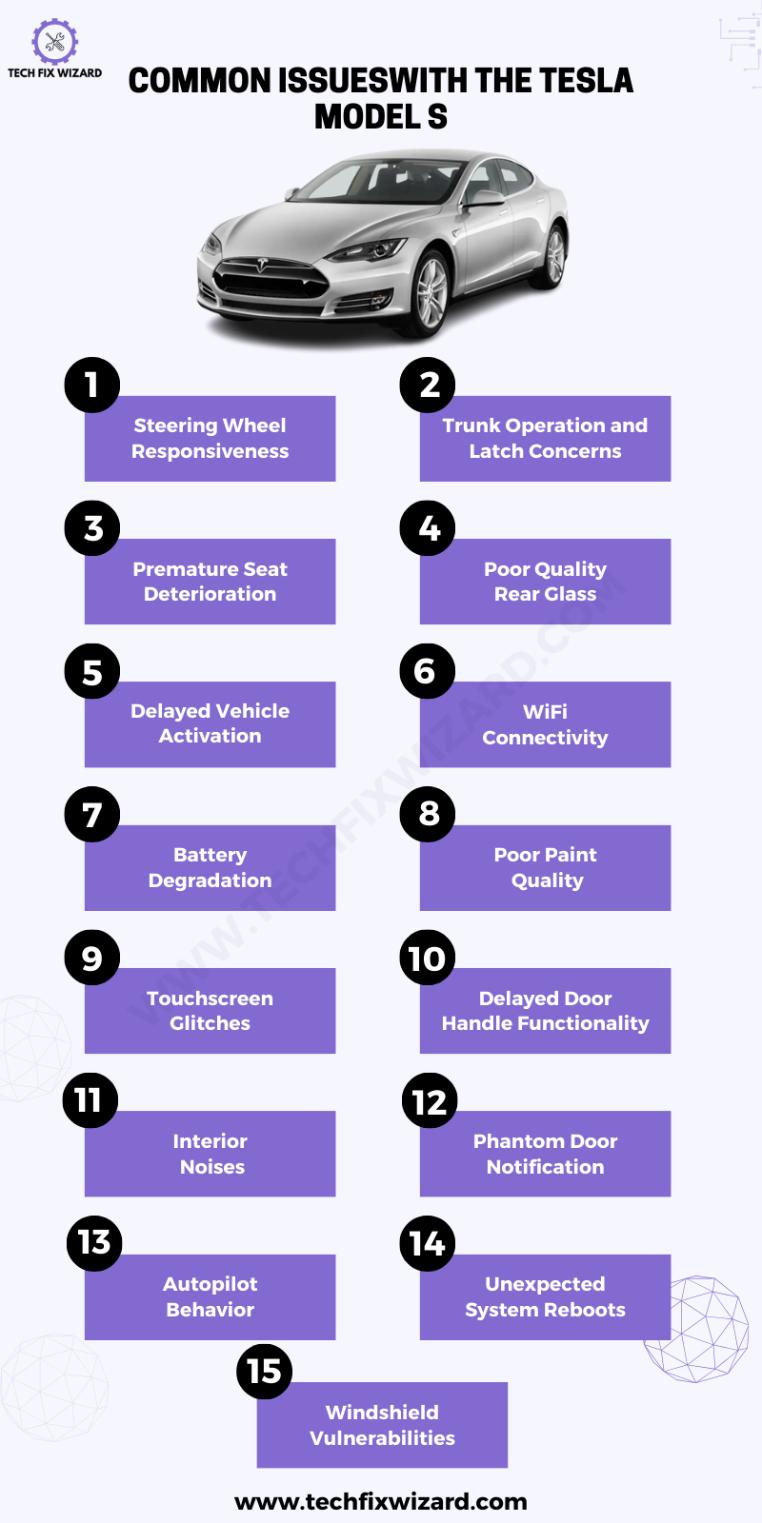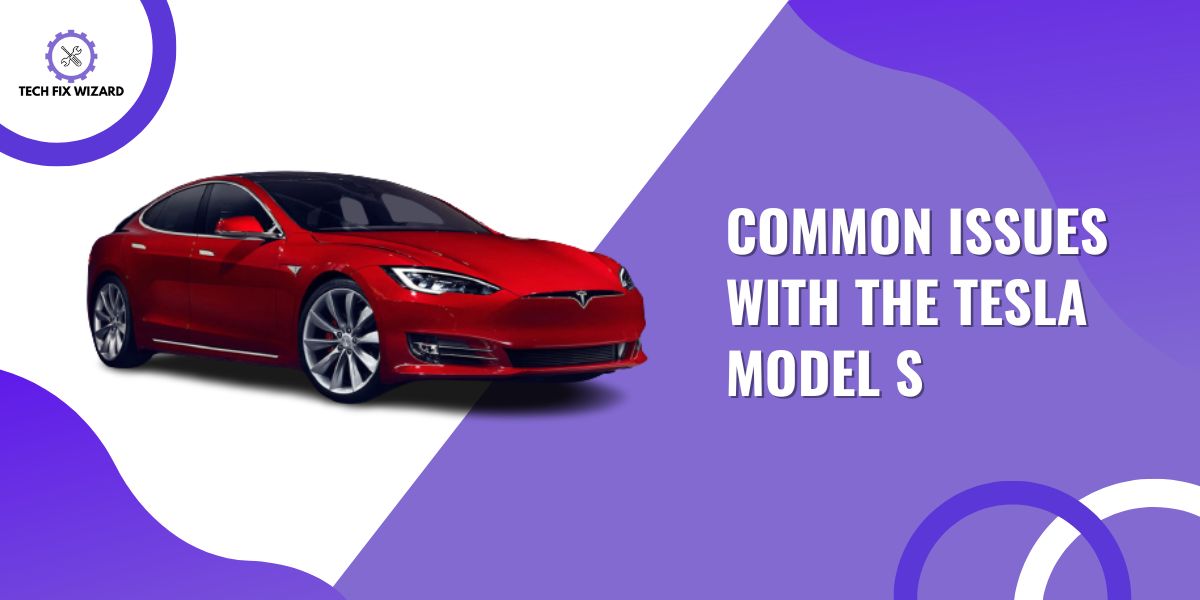Welcome to a comprehensive overview of common issues frequently reported by Tesla Model S owners.
While the Model S is celebrated for its cutting-edge technology and electric performance, like any complex piece of machinery, it can encounter a range of challenges.
In this article, we’ll discuss some of the common issues with the Tesla Model S. Let’s find out!
Contents
- 1 Common Issues With the Tesla Model S
- 2 1. Steering Wheel Responsiveness and Operational Inconsistencies
- 3 2. Trunk Operation and Latch Concerns
- 4 3. Premature Seat Deterioration
- 5 4. Poor Quality Rear Glass (Distorted Rear View)
- 6 5. Delayed Vehicle Activation
- 7 6. WiFi Connectivity
- 8 7. Battery Degradation
- 9 8. Poor Paint Quality
- 10 9. Touchscreen Glitches
- 11 10. Delayed Door Handle Functionality
- 12 11. Interior Noises
- 13 12. Phantom Door Notifications
- 14 13. Autopilot Behavior
- 15 14. Unexpected System Reboots
- 16 15. Windshield Vulnerabilities (Cracks and Fractures)
- 17 4 Other Common Challenges Faced by Tesla Model S Owners
- 18 FAQs
- 19 1. Why is my Tesla Model S experiencing reduced range over time?
- 20 2. Why is my Tesla Model S’s touchscreen freezing or acting unresponsive?
- 21 3. What’s causing the excessive door handle retraction delay on my Model S?
- 22 4. Why do I experience creaking or rattling noises from my Model S’s interior?
- 23 5. Why is my Tesla Model S showing “phantom” door openings on the screen?
- 24 6. What causes the air suspension system on my Model S to fail intermittently?
- 25 7. Why are my Tesla Model S’s Autopilot or Full Self-Driving features behaving erratically?
- 26 8. Why is the paint on my Tesla Model S chipping or showing signs of wear quickly?
- 27 9. What’s causing the unusual tire wear pattern on my Model S?
- 28 10. Why is the panoramic sunroof on my Model S leaking or making noise?
Common Issues With the Tesla Model S
Now, let’s explore the common issue with the Tesla Model S. By becoming familiar with these challenges, you’re better prepared to make an informed decision regarding your potential ownership of this innovative electric vehicle

1. Steering Wheel Responsiveness and Operational Inconsistencies
Numerous Tesla Model S owners have reported instances of unresponsive steering wheels or instances of sticking, presenting consequential safety concerns during operational use.
These issues may originate from electrical irregularities or software glitches inherent within the car’s control systems.
Quick Suggestion:
Perform a software update on the Tesla Model S to ensure the latest firmware is installed. If the issue persists, contact Tesla service for a potential hardware inspection or replacement.
2. Trunk Operation and Latch Concerns
The convenience of accessing the trunk has been compromised by issues related to the trunk failing to open or secure properly.
This manifests as instances where the trunk lid doesn’t respond as expected to commands or experiences difficulty latching securely when closed.
This type of malfunction not only presents inconvenience but can also evoke concerns about the safety and security of items stored within the trunk.
Quick Suggestion:
Lubricate trunk latch mechanism regularly to ensure smooth operation. If problems persist, consult Tesla service for adjustments or potential replacement of faulty components.
3. Premature Seat Deterioration
Reports of premature wear and degradation in the upholstery of Model S seats have also surfaced, casting a potential shadow on the long-term interior comfort and aesthetic appeal.
Premature wear and degradation can manifest as visible signs of fading, cracking, or even tearing in the seat material.
This not only impacts the visual appeal of the interior but could also compromise the comfort and support the seats are designed to provide during drives, particularly on longer journeys.
Quick Suggestion:
Regularly clean and condition leather or upholstery seats using appropriate products. Consider seat covers for added protection against wear and tear.
Also Read: Tesla Brake Not Working – Resolved In 9 Easy & Effective Steps
4. Poor Quality Rear Glass (Distorted Rear View)
Certain Model S proprietors have observed distortions or aberrations within the rear glass, impacting rearward visibility and potentially compromising overall vehicular safety.
This issue is of particular importance, as clear and accurate visibility is essential for safe driving and maneuvering.
When the rear view is compromised due to distorted glass, it can potentially lead to blind spots, misjudgments while reversing, and overall diminished awareness of the surroundings.
Quick Suggestion:
Contact Tesla service for inspection and potential replacement of rear glass. Ensure proper installation and alignment to mitigate distortion issues.
5. Delayed Vehicle Activation
Incidents of the Model S experiencing delayed activation after being unlocked have been documented.
Such delays can precipitate annoyance and potential inconveniences, particularly when immediate vehicle utilization is imperative.
Quick Suggestion:
Ensure the Tesla mobile app is updated and functioning properly. Check internet connectivity and proximity to the vehicle for optimal performance.
6. WiFi Connectivity
There are challenges concerning stable WiFi connectivity as well. This issue can have broader implications beyond just internet access, as it can hinder crucial software updates and impact the effectiveness of various connectivity-dependent features.
A reliable WiFi connection is essential for downloading and installing these updates, ensuring that your vehicle remains up-to-date with the latest improvements and enhancements.
Furthermore, the connectivity features that rely on a consistent internet connection, such as remote vehicle monitoring, app control, and navigation, might also be affected by WiFi discontinuity.
Interruptions in connectivity could lead to delays in accessing real-time data and controlling your vehicle remotely.
Quick Suggestion:
Reset network settings on the Tesla Model S and reconfigure WiFi connections. Ensure the WiFi signal is strong and compatible with the vehicle’s system.
You Might Also Like: Spotify Not Working On Tesla – 9 Solutions
7. Battery Degradation
Over time, repeated charge and discharge cycles can lead to a decrease in the battery’s capacity and overall performance.
This means that the car’s range per charge may gradually diminish, affecting the convenience of longer trips and necessitating more frequent charging.
However, the degradation level of the Tesla Model Sis is much better than that of many other vehicles’ mileage performances.
Quick Suggestion:
Maintain regular charging habits within recommended guidelines. Avoid frequent deep discharges and high charge levels to prolong battery life. Consult Tesla service for battery health diagnostics if degradation is significant.
8. Poor Paint Quality
Maintaining a high-quality paint finish is essential for the appearance and value of any vehicle, and some Model S owners have noted inconsistencies in paint quality.
This can include uneven paint application, imperfections, or color mismatches. While Tesla strives for a high standard of paint quality, occasional issues may arise.
Quick Suggestion:
Apply ceramic coatings or paint protection films to enhance durability and resistance to environmental factors. Regularly wash and wax the vehicle to maintain paint quality.
9. Touchscreen Glitches
The touchscreen interface of the Tesla Model S is a central hub for various vehicle controls, navigation, and entertainment features.
However, some owners have reported instances of glitches and unresponsiveness in the touchscreen display
These issues can lead to frustration and pose safety risks if critical controls become inaccessible while driving.
Quick Suggestion:
Perform a system reboot by holding down both steering wheel scroll buttons until the touchscreen restarts. If issues persist, consult Tesla’s service for further diagnostics and potential software updates.
People Also Read: Tesla Key Card Not Working – Try These 8 Solutions
10. Delayed Door Handle Functionality
The retractable door handles of the Tesla Model S contribute to its sleek design, but certain owners have encountered delays in their functionality.
When approaching the vehicle, these handles are supposed to extend for convenient access, but malfunctions or delays in their operation can lead to inconvenience.
Quick Suggestion:
Keep door handles clean and free of debris. If delays persist, contact Tesla service for potential adjustments or replacement of the door handle mechanism.
11. Interior Noises
While the Tesla Model S is praised for its quiet electric powertrain, some owners have reported experiencing interior rattles, creaks, or other unwanted noises during driving.
These noises can detract from the premium feel of the vehicle and lead to a less enjoyable driving experience. Identifying the source of the noises can be challenging.
Quick Suggestion:
Inspect interior components for loose fittings or trim pieces. Apply sound-dampening materials as needed. If noises persist, consult Tesla’s service for further investigation.
12. Phantom Door Notifications
Receiving false door open notifications despite doors being securely closed is an issue that has raised concerns among Tesla Model S owners.
These false alerts can be distracting and lead to unnecessary worry, potentially affecting the driving experience.
Quick Suggestion:
Ensure all doors are securely closed and latched. Reset the vehicle’s computer system by turning off the car and waiting for a few minutes before restarting.
13. Autopilot Behavior
Tesla’s Autopilot feature represents a significant step toward autonomous driving, providing advanced driver-assistance capabilities to Model S owners.
However, like any evolving technology, there have been instances where the Autopilot system has exhibited behaviors that require further refinement.
Some Model S owners have reported situations in which the Autopilot system misinterprets road conditions, leading to suboptimal decision-making.
Instances of the system not responding appropriately to traffic signals or unexpected disengagement have also been noted.
Quick Suggestion:
Calibrate Autopilot sensors regularly according to Tesla’s recommendations. Stay attentive and ready to take control if Autopilot behavior seems erratic or unpredictable.
14. Unexpected System Reboots
Some Tesla Model S owners have reported instances of unexpected system reboots within their vehicles.
These reboots can occur while driving or during stationary periods and may impact various vehicle systems and functionalities.
Unexpected system reboots can lead to disruptions in driving experiences, causing temporary loss of access to essential controls and features.
This can be particularly concerning if reboots happen while driving, as it might lead to a momentary loss of control or access to critical information.
System reboots could be triggered by software glitches, conflicts between running processes, or issues with the vehicle’s electronic components.
Quick Suggestion:
Check for available software updates and install them promptly. If reboots persist, consult Tesla service for potential hardware issues or diagnostics.
15. Windshield Vulnerabilities (Cracks and Fractures)
One of the noteworthy issues that have come to light among Tesla Model S owners is the susceptibility of the windshield to unexpected cracks and fractures.
Some owners have reported instances of windshields spontaneously cracking or shattering, which has understandably raised safety concerns.
A weakened windshield might compromise the effectiveness of airbags, alter the vehicle’s structural stability during collisions, and hinder the functionality of advanced driver-assistance systems like Autopilot.
While the exact causes behind these windshield vulnerabilities might vary, factors such as temperature fluctuations, road vibrations, and even manufacturing inconsistencies could contribute to their occurrence.
Quick Suggestion:
Avoid impacts and road debris whenever possible. Repair minor cracks promptly to prevent them from spreading. Consider windshield protection films for added durability. If damage is severe, consult Tesla’s service for windshield replacement options.
4 Other Common Challenges Faced by Tesla Model S Owners
A few other challenges experienced by Tesla Model S owners are listed below:
| No. | Challenges | Description |
|---|---|---|
| 1. | Service Center Limitations | Restricted Tesla service center availability and extended wait times lead to owner dissatisfaction in seeking maintenance. |
| 2. | Erosion of Resale Value | Declining Model S resale value attributed to pricing, subsequent models, and persistent concerns about its range. |
| 3. | Range Concerns | Some owners express concerns about Model S range adequacy, especially in colder climates or for long journeys. |
| 4. | Extended Charging Periods | Prolonged charging with standard outlets inconveniences owners, affecting time-sensitive plans and activities. |
FAQs
1. Why is my Tesla Model S experiencing reduced range over time?
Over time, lithium-ion batteries in electric vehicles like the Model S can degrade, leading to decreased range. Factors like frequent fast charging, extreme temperatures, and high mileage can accelerate this degradation.
2. Why is my Tesla Model S’s touchscreen freezing or acting unresponsive?
Some users have reported issues with the central touchscreen freezing or becoming unresponsive. This could be due to software glitches or updates. Restarting the car or performing a hard reset might help resolve the issue.
3. What’s causing the excessive door handle retraction delay on my Model S?
The retractable door handles on the Model S may sometimes have a delay in deploying, or they might not deploy at all. This could be due to sensor issues or software bugs.
4. Why do I experience creaking or rattling noises from my Model S’s interior?
Some Model S owners have reported interior rattling or creaking sounds, often attributed to loose trim or panels. This could be due to manufacturing inconsistencies or wear over time.
5. Why is my Tesla Model S showing “phantom” door openings on the screen?
There have been instances where the Model S’s touchscreen displays that a door is open even when it’s not. This could be due to sensor malfunctions or software glitches.
6. What causes the air suspension system on my Model S to fail intermittently?
The air suspension system in the Model S can occasionally experience failures or uneven performance. This might result from sensor issues, air leaks, or problems with the compressor.
7. Why are my Tesla Model S’s Autopilot or Full Self-Driving features behaving erratically?
Some users have reported inconsistencies or unexpected behavior with Autopilot and Full Self-Driving features. Software updates and calibration issues could be potential causes.
8. Why is the paint on my Tesla Model S chipping or showing signs of wear quickly?
Some Model S owners have reported issues with the paint quality, such as premature chipping or peeling. This might result from various factors, including environmental conditions and manufacturing processes.
9. What’s causing the unusual tire wear pattern on my Model S?
Uneven tire wear can occur due to misalignment, suspension issues, or aggressive driving. Regular maintenance and alignment checks can help prevent this problem.
10. Why is the panoramic sunroof on my Model S leaking or making noise?
A few Model S owners have reported leaks or excessive noise from the panoramic sunroof. This could be due to improper installation, seal issues, or wear over time.

John Paul is a tech enthusiast dedicated to troubleshooting. He is passionate about fixing glitches, simplifying complexities, and empowering others in the digital realm.

